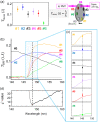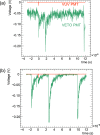Controlling 229Th isomeric state population in a VUV transparent crystal
- PMID: 39013899
- PMCID: PMC11252313
- DOI: 10.1038/s41467-024-49631-0
Controlling 229Th isomeric state population in a VUV transparent crystal
Abstract
The radioisotope thorium-229 (229Th) is renowned for its extraordinarily low-energy, long-lived nuclear first-excited state. This isomeric state can be excited by vacuum ultraviolet (VUV) lasers and 229Th has been proposed as a reference transition for ultra-precise nuclear clocks. To assess the feasibility and performance of the nuclear clock concept, time-controlled excitation and depopulation of the 229Th isomer are imperative. Here we report the population of the 229Th isomeric state through resonant X-ray pumping and detection of the radiative decay in a VUV transparent 229Th-doped CaF2 crystal. The decay half-life is measured to 447(25) s, with a transition wavelength of 148.18(42) nm and a radiative decay fraction consistent with unity. Furthermore, we report a new "X-ray quenching" effect which allows to de-populate the isomer on demand and effectively reduce the half-life. Such controlled quenching can be used to significantly speed up the interrogation cycle in future nuclear clock schemes.
© 2024. The Author(s).
Conflict of interest statement
The authors declare no competing interests.
Figures








References
-
- Peik E, Tamm C. Nuclear laser spectroscopy of the 3.5 eV transition in Th-229. Euro. Phys. Lett. 2003;61:181. doi: 10.1209/epl/i2003-00210-x. - DOI
-
- Peik E, Tamm C. Nuclear clocks for testing fundamental physics. Quantum Sci. Technol. 2021;6:034002. doi: 10.1088/2058-9565/abe9c2. - DOI
-
- Beeks K, et al. The thorium-229 low-energy isomer and the nuclear clock. Nat. Rev. Phys. 2021;3:238. doi: 10.1038/s42254-021-00286-6. - DOI
Grants and funding
- JP19K21879/MEXT | Japan Society for the Promotion of Science (JSPS)
- JP19K14740/MEXT | Japan Society for the Promotion of Science (JSPS)
- JP21H01094/MEXT | Japan Society for the Promotion of Science (JSPS)
- JP19H00685/MEXT | Japan Society for the Promotion of Science (JSPS)
- 856415/EC | EU Framework Programme for Research and Innovation H2020 | H2020 Priority Excellent Science | H2020 European Research Council (H2020 Excellent Science - European Research Council)

